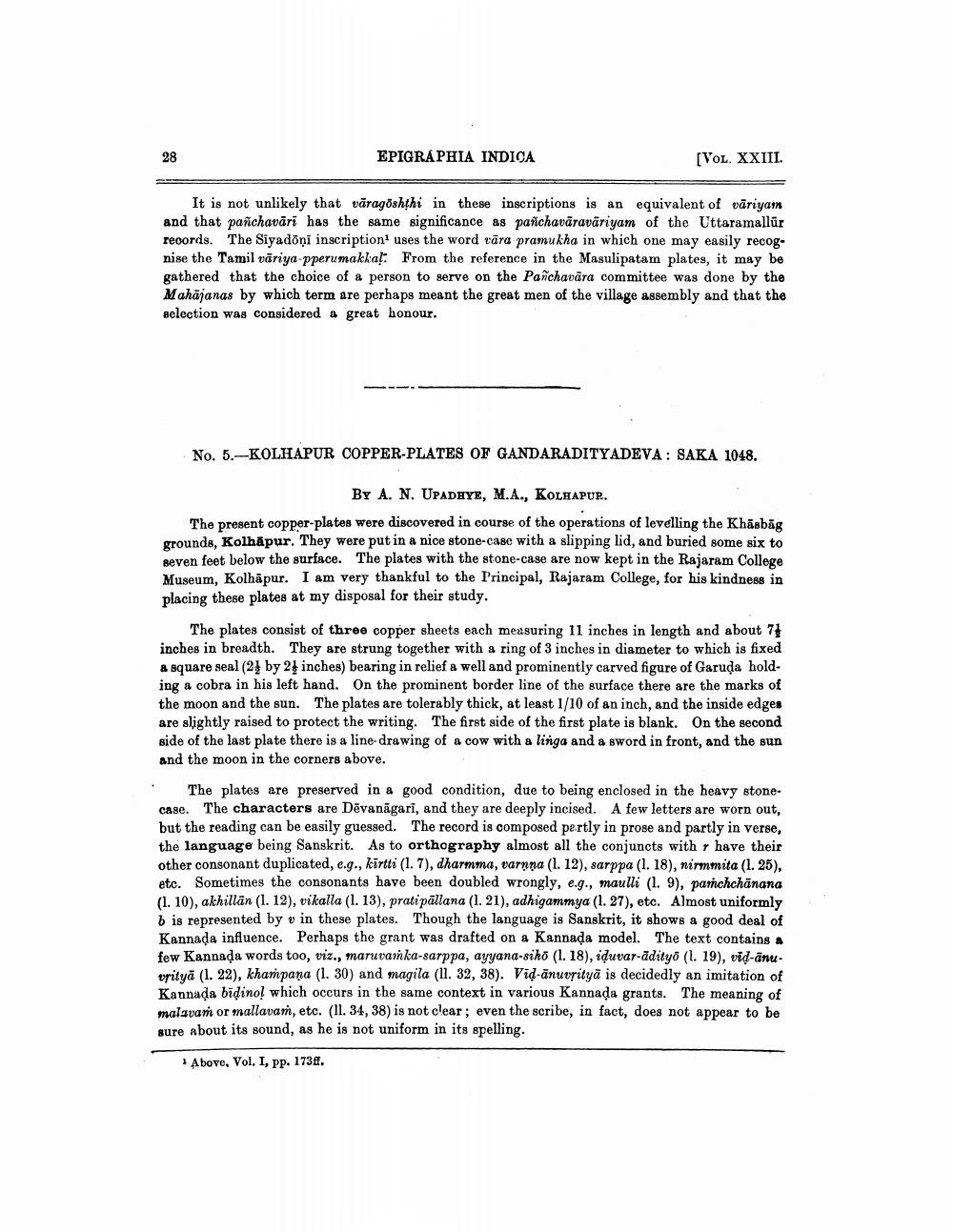________________
28
EPIGRAPHIA INDICA
[VOL. XXIII.
It is not unlikely that väragoshthi in these inscriptions is an equivalent of väriyam and that pañchavāri has the same significance as pañchavaravariyam of the Uttaramallur records. The Siyadoņi inscription1 uses the word tāra pramukha in which one may easily recognise the Tamil väriya-pperumakkal. From the reference in the Masulipatam plates, it may be gathered that the choice of a person to serve on the Panchavara committee was done by the Mahajanas by which term are perhaps meant the great men of the village assembly and that the selection was considered a great honour.
No. 5.-KOLHAPUR COPPER-PLATES OF GANDARADITYADEVA: SAKA 1048.
BY A. N. UPADHYE, M.A., KOLHAPUR.
The present copper-plates were discovered in course of the operations of levelling the Khasbag grounds, Kolhapur. They were put in a nice stone-case with a slipping lid, and buried some six to seven feet below the surface. The plates with the stone-case are now kept in the Rajaram College Museum, Kolhapur. I am very thankful to the Principal, Rajaram College, for his kindness in placing these plates at my disposal for their study.
The plates consist of three copper sheets each measuring 11 inches in length and about 7 inches in breadth. They are strung together with a ring of 3 inches in diameter to which is fixed a square seal (2) by 24 inches) bearing in relief a well and prominently carved figure of Garuda holding a cobra in his left hand. On the prominent border line of the surface there are the marks of the moon and the sun. The plates are tolerably thick, at least 1/10 of an inch, and the inside edges are slightly raised to protect the writing. The first side of the first plate is blank. On the second side of the last plate there is a line-drawing of a cow with a linga and a sword in front, and the sun and the moon in the corners above.
The plates are preserved in a good condition, due to being enclosed in the heavy stonecase. The characters are Devanagari, and they are deeply incised. A few letters are worn out, but the reading can be easily guessed. The record is composed partly in prose and partly in verse, the language being Sanskrit. As to orthography almost all the conjuncts with r have their other consonant duplicated, e.g., kirtti (1. 7), dharmma, varnna (1. 12), sarppa (1. 18), nirmmita (1.25), etc. Sometimes the consonants have been doubled wrongly, e.g., maulli (1. 9), paṁchchanana (1. 10), akhillän (1. 12), vikalla (1. 13), pratipallana (1. 21), adhigammya (1. 27), etc. Almost uniformly b is represented by v in these plates. Though the language is Sanskrit, it shows a good deal of Kannada influence. Perhaps the grant was drafted on a Kannada model. The text contains a few Kannada words too, viz., maruvaṁka-sarppa, ayyana-sihō (1. 18), iḍuvar-ādityō (1. 19), viḍ-ānuvritya (1. 22), khampana (1. 30) and magila (11. 32, 38). Vid-anuvrityā is decidedly an imitation of Kannada bidinol which occurs in the same context in various Kannada grants. The meaning of malavam or mallavam, etc. (11. 34, 38) is not clear; even the scribe, in fact, does not appear to be sure about its sound, as he is not uniform in its spelling.
1 Above, Vol. I, pp. 173.




